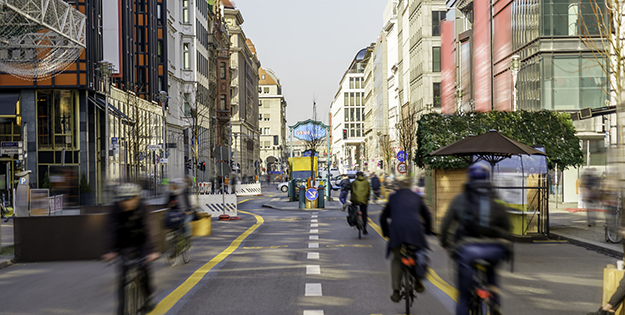Global
Copyright@ Australian Catholic University 1998-2025 | ABN 15 050 192 660 CRICOS registered provider: 00004G | PRV12008
Copyright@ Australian Catholic University 1998-2025 | ABN 15 050 192 660 CRICOS registered provider: 00004G | PRV12008

Ever needed something from the shops – say, a flat white or a loaf of bread – and decided that, rather than walking, you would get behind the wheel and roll to the café or corner store instead? If you live in a suburb of a car-centric city like Sydney or Melbourne, chances are that you do this regularly.
Meanwhile, a whopping 55 per cent of Australian adults don’t move enough on a regular basis – and experts argue that urban planning plays a major role.
When a city is designed with car travel in mind, walking to nearby services like shops and public transport is in many cases unattractive or unfeasible.
“If our city neighbourhoods had more amenities, walking paths, little parks and green areas and other attractions that encourage people to travel by foot, many more people would leave the car at home,” says Professor Ester Cerin, a psychologist and statistician whose research focuses on environmental determinants of lifestyle behaviours.
“Instead, most Australian cities are built around the car, which means there are barriers to walking and other physical activity, and that’s a real problem because active transport is an important element in creating healthy and sustainable lifestyles.”
In a recent study that explored the relationship between urban design, transport and health outcomes in 25 cities around the world, Professor Cerin and her co-authors found that Sydney, Melbourne and Adelaide fell short on key health and sustainability measures.
Published as part of The Lancet Global Health Series and drawing on data from the International Physical Activity and the Environment Network study, the research found that high-income countries like Australia, the United States and New Zealand had the worst performing cities for walkability and urban density.
The researchers involved in the series, which explores the “where to next” for urban design, transport and health, have called for urgent policy reform to help rebuild neighbourhoods for a healthier and more sustainable future.
“It’s a huge challenge because most people don’t understand that urban design can have major impacts on human health,” says Professor Cerin, who leads the Behaviour, Environment and Cognition Research Program at ACU’s Mary MacKillop Institute for Health Research.
“There’s a lack of awareness not only amongst the general public, but also amongst academics and policymakers, so when you say that you’re studying the effects of the built environment on things like cognitive health, even some psychologists, psychiatrists and neuroscientists are puzzled by this idea.”
An added challenge is the cultural barrier to reducing our reliance on cars, which are seen by many city-dwellers as the most convenient and desirable way to get from A to B.
“Cities in Australia are relatively new, and they were mainly developed in a time where cars were seen as a very important aspect of life,” says Professor Cerin, who lives in inner-city Melbourne.
“It’s similar to parts of America, where people have been convinced that a car is an essential element for happiness and a symbol of prosperity, and that has influenced the way cities are built – whereas in other parts of the world, where you have older and more compact cities, they’re much more walkable and that means there’s less dependence on cars.”
You can’t talk for very long about walkable cities without mentioning Europe, which is arguably the world’s most pedestrian-friendly continent.
In many European cities, walkability is increasingly valued not only for its health and environmental benefits, but also for its social and recreational value.
“In Europe, you generally have older cities that were developed long before we had cars, so they’re extremely walkable – they’re compact, they’re mixed-use, and they have everything you need in a community,” says Professor Cerin, who was raised in Istria, an Italian-speaking region of Croatia, and has also lived in Hong Kong and the United States.
“The compact nature of many European cities also makes them much more social and community-focused, and because people tend to have less space in their homes, they’re more likely to get outside and interact with their neighbours, which also has benefits for both physical and mental health.”
In a Lancet study that was co-authored by Professor Cerin and led by Dr Melanie Lowe from the University of Melbourne, walkable and activity-friendly neighbourhoods were found to be associated with a reduction in a range of chronic diseases. The researchers concluded that city planning policies “have a crucial role in preserving or damaging health and sustainability”.
While many cities in Europe and Latin America are taking steps toward more walkable and compact neighbourhoods, most Australian cities appear to be heading in the other direction.

The intensification of urban and suburban sprawl in places like Perth and Canberra means neighbourhoods – and neighbours – are growing further and further apart.
This not only has implications for health; it also affects climate change mitigation efforts. Research has found that doubling urban density significantly reduces carbon pollution from household travel and energy use.
So, how do you convert a sprawling city that is dominated by cars into a pedestrian-friendly place?
The first step, says Professor Cerin, is densification: Taller buildings that house more people and are surrounded by urban infrastructure.
“We need neighbourhoods that contain all the facilities you need for daily living: Shops, schools, medical facilities, health facilities, recreational facilities, green spaces, and places where you can interact with others,” she says, pointing to the concept of the 15-Minute City, an idea that arose during the early days of the pandemic and has been gaining ground ever since.
“It’s a way of transforming a sprawling place into a liveable, walkable city. But that requires converting some residential areas into mixed-use areas, and it requires greater density, because you need population in order to sustain businesses and make public transport feasible.”
Through her research, Professor Cerin has calculated that walkable and sustainable city neighbourhoods require at least 5,700 people per square kilometre. At present, this is easily reached in parts of inner Melbourne and Sydney (Potts Point, for example, boasts 16,400 people per sq km). But once you enter suburbia in these cities, it’s increasingly a picture of uncontrolled sprawl.
In Adelaide, not even the inner suburbs meet the population threshold required for a compact and walkable city – and plans to increase density are often met with resistance.
One problem in Australia and many other westernised countries is that people generally view increased urban density as an undesirable outcome, with talk of “shoeboxes” or “urban slums”.
The solution to this, according to Professor Cerin and many of her contemporaries, is raising awareness of the benefits of urban density.
Forget the concrete jungles of the past, and instead, picture lively green neighbourhoods that are pedestrian-friendly, where spaces are designed for people rather than cars, where public transport is frequent and reliable, and where there are many places to play and socialise.
“I know people who have travelled around the world and lived in different places, and when they experience a place that is really compact and easy to walk in and then they go back home to their sprawling and car-centric city, they can see that living in walkable place has many, many benefits,” she says.
“We have to make people aware that you don’t need to have a massive house with a huge garden to be happy and functional in life, and you don’t always have to travel by car.”
So, apart from more people and taller buildings, what else does a city need to be walkable?
“You definitely need street connectivity – lots of road intersections, cycleways and walking paths that encourage residents to travel by foot,” says Professor Cerin, who stresses the need for pedestrian-centric areas that are safe enough for children to walk in.
“I think of my own childhood, and I lived in an environment where traffic safety wasn’t an issue at all. It was full of little intricate streets and a fantastic environment for play, because it was complex and it stimulated our imagination.
“Kids would really benefit from having the freedom to roam in a safe neighbourhood environment where they explore the world around them. Each community can be like a little village, providing all the stimulation that kids need, while at the same time encouraging adults to get out on their feet, interacting with others in their neighbourhood.”
As for the question of “where to next” for cities around the globe, Professor Cerin envisages a future in which good city planning produces a range of benefits for both people, and the planet we live on.
“You start with research, you go out measure what needs to be measured, and once you’re clear on your findings, the goal becomes to communicate that information to policymakers so you influence and guide decisions about what must change in order to create healthy and sustainable cities,” says Professor Cerin, who has authored more than 250 articles in high-impact international journals.
“So much of the world’s population lives in cities, and given the many challenges we are facing, we know this is an important agenda. In the end, the purpose of the research is to have a positive impact on society – that’s the goal we focus on as we try to make things happen.”
Professor Ester Cerin is one of the world’s leading researchers on the environmental and psychosocial determinants of lifestyle behaviours and health across the lifespan. Before joining ACU, she worked across Australia, the USA and Hong Kong.

Copyright@ Australian Catholic University 1998-2025 | ABN 15 050 192 660 CRICOS registered provider: 00004G | PRV12008